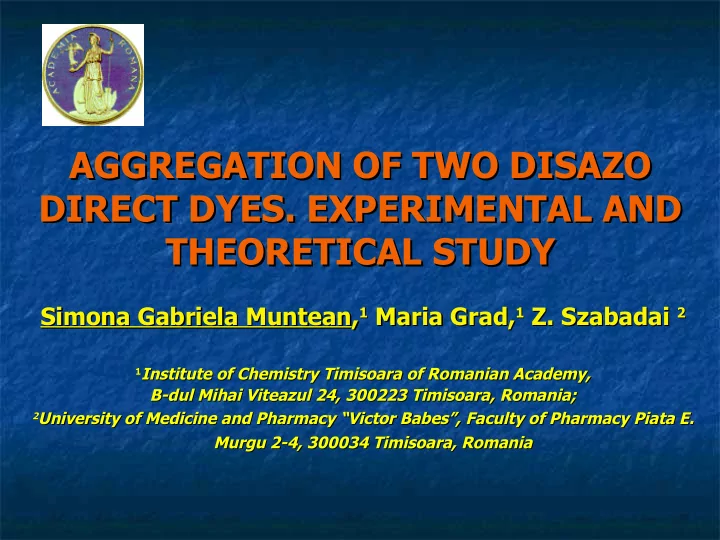

AGGREGATION OF TWO D DISAZO ISAZO AGGREGATION OF TWO DIRECT DYES S. EXPERIMENTAL AND . EXPERIMENTAL AND DIRECT DYE THEORETICAL STUDY THEORETICAL STUDY Simona Gab briela Muntean riela Muntean, , 1 Maria Grad, Maria Grad, 1 Z Z. . Szabadai Szabadai 2 Simona Ga 1 1 2 Institute of Chemistry Timisoara of Romanian Academy, 1 Institute of Chemistry Timisoara of Romanian Academy, 1 B-dul Mihai Viteazul 24, 300223 Timisoara, Romania; B-dul Mihai Viteazul 24, 300223 Timisoara, Romania; University of Medicine and Pharmacy “Victor Babes”, Faculty of Pharmacy Piata E. 2 University of Medicine and Pharmacy “Victor Babes”, Faculty of Pharmacy Piata E. 2 Murgu 2-4, 300034 Timisoara, Romania Murgu 2-4, 300034 Timisoara, Romania
Introduction Introduction Adsorption of dyes on solid adsorbents is Adsorption of dyes on solid adsorbents is influenced by the physicochemical properties influenced by the physicochemical properties of the dyes solutions. of the dyes solutions. Azo dyes are compounds whose molecules Azo dyes are compounds whose molecules have a tendency to self-associate in the have a tendency to self-associate in the ground electronic state. That can lead to the That can lead to the ground electronic state. formation of dimers, trimers, and tetramers. formation of dimers, trimers, and tetramers. n D D n T T he main factors influencing aggregation are: he main factors influencing aggregation are: dye structure, dye concentration, electrolyte dye structure, dye concentration, electrolyte concentration, and temperature. concentration, and temperature.
Aim Aim Investigation of the molecular aggregation of two direct dyes Investigation of the molecular aggregation of two direct dyes in aqueous solution, as a function of dye concentration. in aqueous solution, as a function of dye concentration. Mathematical analysis of the aggregation of the studied dyes. of the aggregation of the studied dyes. Mathematical analysis
Experimental Experimental H 2 NOC SO 3 Na CONH 2 H O N N N N OH H H NaO 3 S DSA SO 3 Na SO 3 Na NH 2 N N N N H H NaO 3 S NaO 3 S H 2 N DAN Fig. 1. The structure of the studied disazo dyes
Results and Discussions Results and Discussions 1.0 DAN DSA -3 M 1*10 0.8 -4 M 5*10 -3 1*10 0.8 -4 M 1*10 -4 5*10 -1 ) -1 cm -1 ) 0.6 -5 M 5*10 -4 1*10 -1 cm 0.6 -5 M 1*10 4 (M -5 5*10 4 (M -5 M 5*10 -5 ε / 10 1*10 0.4 ε / 10 -6 M 1*10 -6 0.4 5*10 -6 1*10 0.2 0.2 0.0 0.0 300 400 500 600 700 800 300 400 500 600 λ (nm) λ (nm) Fig. 2. Direct dyes DSA and DAN absorption spectra at different concentrations
DSA 0.9 0.8 0.7 -1 ) Absorption coefficient (410 nm) -1 cm 0.6 0.9 4 (M DAN 0.5 ε / 10 0.8 0.4 0.7 0.3 0.6 -1 ) Absorption coefficient (500 nm) -1 cm 0.2 0.5 0.0 0.2 0.4 0.6 0.8 1.0 4 (M Initial concentration (mM) ε / 10 0.4 0.3 0.2 0.1 0.0 0.2 0.4 0.6 0.8 1.0 Initial concentration (mM) Figure 3. The trend in studied dye’s absorption coefficient as concentration varies
Matematical analysis Using the experimental absorbance values, an n x m Using the experimental absorbance values, an n x m (n: values of absorption at different wavelength, (n: values of absorption at different wavelength, m: concentrations) dimension matrix was build for a m: concentrations) dimension matrix was build for a series of analytical concentrations. series of analytical concentrations. The number of eigenvalues of this matrix different The number of eigenvalues of this matrix different from zero (within accepted experimental errors) is from zero (within accepted experimental errors) is equal to the number of chemical species (monomer, equal to the number of chemical species (monomer, dimer, etc.) presented in the system. dimer, etc.) presented in the system.
Matriceal Analysis Matriceal Analysis The eigenvalues value of the absorption matrix for DSA and DAN dyes DSA DAN -3.084 x 10 -15 -3.983 x 10 -15 3.985 x 10 -14 2.371 x 10 -5 1.399 x 10 -13 1.938 x 10 -4 1.566 x 10 -4 3.783 x 10 -4 1.001 x 10 -3 2.584 x 10 -3 0.087 0.025 3.289 8.339 163.642 116.417
Conclusion UV-Vis spectroscopy has been used to study UV-Vis spectroscopy has been used to study the aggregation of two disazo direct dyes the aggregation of two disazo direct dyes (DSA DSA, , DAN DAN) in aqueous solution; ) in aqueous solution; ( The dyes aggregation depends on the The dyes aggregation depends on the concentration. concentration. From the matriceal analysis, the number of From the matriceal analysis, the number of chemical species presented in the system was chemical species presented in the system was determined, in domain of concentrations determined, in domain of concentrations studied. studied.
Thank you! Thank you!
Recommend
More recommend